“Hey, Mom! I signed up for the band! I need to get an instrument.”
These words might strike panic in a parent who is already juggling other extracurriculars and expenses. But learning a musical instrument doesn’t have to be as overwhelming as you might think.
Musical proficiency is a journey. So it helps for parents to take that musical journey one stage at a time.

The journey to learning an instrument is like a symphony, consisting of distinct movements. From selecting an instrument to establishing practice routines and (potentially) pursuing music in college… Each movement blends seamlessly into the next when you know the right steps to take.
Whether you are an avid musician yourself or you have never picked up an instrument, it’s okay! You can follow these steps (or “movements”) to navigate your child’s musical journey.
- MOVEMENT 1: Choose and Obtain Your Beginner Instrument
- MOVEMENT 2: Establish Good Practice Habits
- MOVEMENT 3: Move to an Intermediate Instrument
- MOVEMENT 4: Expand Performance Opportunities
- MOVEMENT 5: Choose Your Musical Future
- MOVEMENT 6: Prepare for the Future That’s Chosen

MOVEMENT 1: Choose and Obtain Your Beginner Instrument
Timeframe: A few weeks or months prior to the first band or orchestra class.
1. Exposure to Music Opportunities in School
Most students have school music opportunities like orchestra and band between 4th and 6th grade. For students who haven’t taken lessons outside of school, this is often their first realization that they could actually play an instrument. This sparks curiosity in many kids and is the start of their musical journey.
2. Trying Instruments at the Start of the Musical Journey
Many schools will facilitate an “Instrument Petting Zoo” or “Instrument Fitting.” This lets students try different instruments. This is an essential part of the selection process — kids need to make sounds and find one that fits them. Some will prefer wind instruments or percussion. Others might like string instruments such as the viola or bass.
Every child should try an instrument as part of their musical journey!
This is the beginning of choosing whether to join the orchestra (string instruments) or band (brass, woodwind, and percussion). They can hear the difference between flute, trombone, and cello sounds to see what resonates with them.
Every child should try an instrument as part of their musical journey, so encourage your child to do so. Many reluctant students have ignited a passion for music they never knew was inside of them. At this stage, most kids are beginners, so it’s the perfect time to try without feeling embarrassed.
Many kids don’t think that they can play an instrument. So if they are “required” to try, they’ll find out that they can and want to keep learning.
3. Choosing an Instrument to Play
There are five main considerations for selecting the instrument your child should learn. I’ve listed them in order from most to least important. It won’t necessarily be intuitive, but I’ll make sense of it as we go.
First Consideration: What Instrument Sounds Best to Them?
If the sound is pleasing to their ear, they’ll want to continue playing it. There’s a positive cycle that happens in their brains when they enjoy the instrument they play.
Positive Cycle:
- They like how it sounds, so
- They make it make sounds (practice and perform), so
- They get better at it, so
- They have more fun with it, so
- They make it make sounds… The cycle continues.
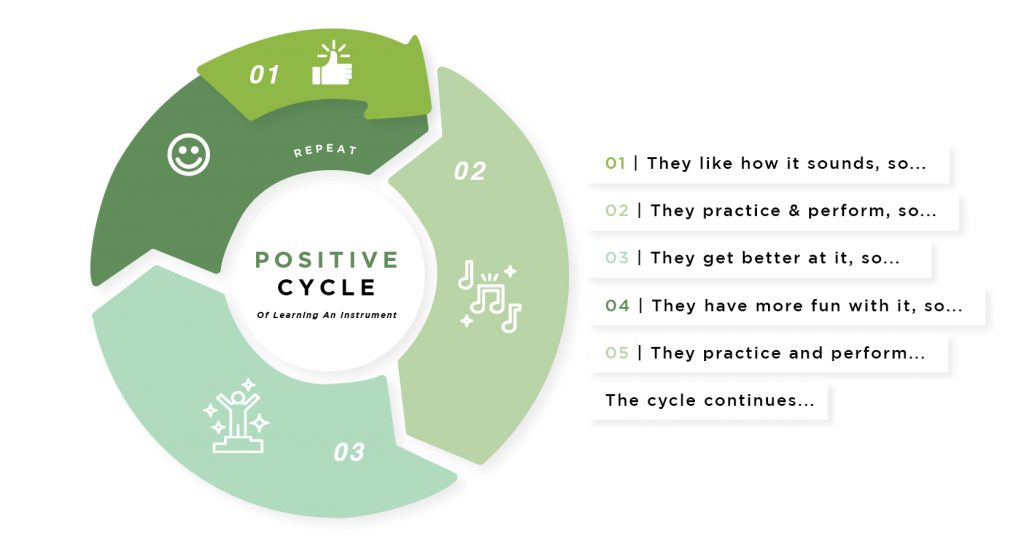
However, if they choose an instrument that doesn’t sound good to them, or even irritates them, they’ll have the opposite outcome.
Negative Cycle:
- They don’t like how it sounds but were forced to play it, so
- They don’t make it make sounds (by practicing), so
- They don’t improve and fall behind, so
- They have no fun playing it, so
- They don’t make it make sounds… Eventually, they quit.
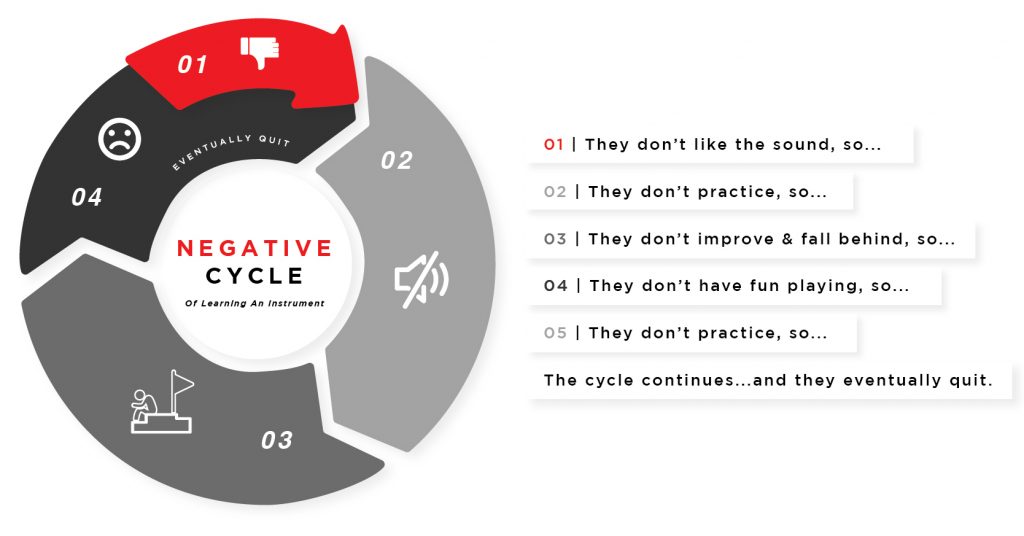
To avoid the negative cycle, here is how to choose what sound your child likes best:
- Have them listen to solo music with people playing that instrument. Then, they can clearly hear what it sounds like.
- Accompaniment can influence whether or not they like the sound. So be sure they are hearing that particular instrument, not the sound coming from a different instrument in the song. If they can listen to it unaccompanied, that’s best!
Second Consideration: Which Instrument Gives Them the Most Success in Making a Sound?
Trying to produce a joyful noise out of an instrument that doesn’t suit them can be an exercise in frustration and futility. It’s important to keep trying and not give up.
But there will be certain instruments students will find easier to play than others. So help them choose one they’re more comfortable with.
Third Consideration: What Physical Challenges Could Prevent Their Success in Their Musical Journey?
Some physical features make playing certain instruments more of a challenge. To give them the greatest chance to succeed, help students avoid instruments that may not be a fit for them. Many students think braces are a hurdle to playing wind instruments, but this is rarely an issue. Some examples of potential difficulties include:
- Tear-drop lips for flute players: This splits their airstream, making it difficult to produce a consistent, even sound.
- Large lips for small mouthpieces: The fit can make it challenging to align with the center of a brass mouthpiece and direct the air.
- Amputees: Some instruments require both hands, like flutes, trombones, and violins. Try different instruments to see if one will work with whatever challenges you face.
Of course, most, if not all, of these hurdles can be overcome with determination and a love for the sound of the instrument! That’s why the first two considerations are more important.
Fourth Consideration: What Other Desires and Obligations Do They Have?
For example, is your child a middle-schooler who wants to be in the high school marching band one day? It would be wise for them to start with a band instrument rather than an orchestra instrument. If they have to lug football or lacrosse gear to school, they might not want to also carry a tuba.
Think about how the instrument fits into their current lifestyle, as well as their future musical dreams.
Fifth Consideration: What Can We Afford?
This consideration is last for a reason. If you have an instrument in your closet, but your child doesn’t like the sound, it’s likely they will quit.
Remember the Negative Cycle we just talked about? 😉
The money you would put into it will likely go to waste.
It would be more beneficial to spend some money on an instrument they like the sound of. Then, they have a greater chance of success. Also, you’ll see a greater return on your investment!
4. Obtaining Your Child’s Instrument
So you’ve settled on the ideal instrument, and now you need to find one. There are many ways to get an instrument. The two most popular options are renting to own and buying. Take a look at the pros and cons of renting to own versus buying an instrument.
Buying:
Some students may be excited to buy their first instrument, but purchasing is not always the best choice. Here are the pros and cons.
Pros:
- In a specific set of circumstances, you may pay less than if you rent toward ownership.
Cons:
- If you purchase a good, reliable instrument, it could be expensive.
- You have to pay for repairs and be without an instrument while it’s fixed.
- If it’s lost or stolen, you’ll have to buy another (unless you cover it on your homeowners or renters insurance)
- You are stuck with it if they don’t end up liking it.
- Students will outgrow fractional-sized string instruments.
- You can’t easily exchange it for a different instrument after they’ve used it for a while.
- They can’t switch it out when they “step up” to more sophisticated instruments down the road.
Renting Toward Ownership:
Renting from a reputable music instrument dealer is an option for your child’s musical journey. It’s often the most economical and practical choice for students starting out on their journey. Take a look at the pros and cons of renting your child’s instrument.
Pros:
- Repairability: If something breaks, your dealer will repair any issues at no additional cost. Also, they will offer you a loaner until it’s fixed.
- Replaceability: If it is lost or stolen, you’ll get a replacement instrument right away.
- Exchangeability: You can move from one instrument to another with rental credit intact. Switch from band to orchestra or upgrade at any time.
- Returnability: If you don’t choose to keep playing, you can return the instrument when you’re done, rather than being stuck with a purchase.
- Affordability: $20-$60 a month is often more affordable than what you would spend on buying a quality instrument for your child.
- Upgradeability: This isn’t true of many reputable companies. But if you find one that lets you upgrade your instrument when your student is ready, you’ve struck gold. It’s possible that all of your money goes toward one instrument that would last them a lifetime.
Cons:
- The cosmetic condition of the instrument is subject to availability.
- It’s possible that you pay more over the life of your rental agreement in a specific set of circumstances.
Quality of Selection:
There is a broad range of instruments available on the market, and you tend to get what you pay for.
ISOs (Instrument-Shaped Objects 😁) are a temptation for parents to purchase when they are new to music. That’s because they are offered at lower prices than quality instruments. Most can’t tell the difference.
But the problems that arise are too plentiful to count. Repair technicians and professional musicians report many issues with ISOs. They include an inability to tune, being difficult to play, corroded brass valves, and improperly fitted woodwind pads.
These instruments cause costly, ineffective repair attempts, and are frustrating to students.
Instead, look for quality student-level instruments designed with learning in mind.
- Student-level instruments will help a child decide if this is the instrument they want to play long-term in their musical journey. Also, it allows them to step up at appropriate intervals.
- ISOs will hinder the child from deciding if this is the instrument they want to pursue. Faulty equipment and sound quality can lead to frustration and a sense of incompetence.
The bottom line: If you find a price that’s too good to be true, it is. Students playing ISO’s won’t succeed the vast majority of the time.
Unfortunately, I see this far too often.
MOVEMENT 2: Establish Good Practice Habits
Timeframe: The first year of playing an instrument.
1. Form a Routine
First things first, decide where you want them to practice. Some kids prefer an audience. But you have things to do, too. So let them practice in the kitchen while you make dinner or in the family room while you fold laundry.
Others prefer privacy, especially in the beginning. So offer them a quiet bedroom or even the back porch in good weather. Set up a time and place that they associate with practice.
And please, don’t banish them to the garage or some other place that makes practice unpleasant!
We know that things don’t sound great at first! But in time, things will better – you may be surprised how quickly.
If you want them to succeed, the last thing you want them to do is feel like they’re being punished when they practice.
For other thoughts about helping your child practice, feel free to check out these practice tips. You can even read tips from other parents, including this mom (who also happens to be in a symphony orchestra).
2. Teach Them to Persevere
No one learns an instrument without some trial and error. Some kids will take to it more naturally, but everyone encounters some hurdles.
Please don’t let them give up at the first signs of struggle. We recommend they try the instrument for at least the first year.
Don’t let your child give up at the first signs of struggle to learn their instrument.
Reward their perseverance with praise and music-themed encouragement. This could include trips to the symphony or downloading a favorite song.
Show them how you persevere through difficult things, rather than chastising them when they struggle. Perseverance is an incredible life lesson.
This is the perfect time to learn it.
3. Try Private Lessons
Private lessons for beginners greatly increase their chance of success. It is an additional investment. But the one-on-one attention can’t be replicated in a group setting.
Each session caters to your child’s individual strengths and weaknesses. Music teachers know what it’s like to learn an instrument and can provide the guidance needed to master the skill.
Private lessons give children a better return on their investment of time and effort. Also, private lessons give parents a better return on their monetary investment.
Private lessons aren’t for everyone. But many who take them will see a much higher success rate because of the individual attention.
4. Consider Changing Instruments (*Only If Necessary)
To be clear, this is something that really ought to be initiated by your music director. If they notice your child has been plucking or blowing away with no improvement or enjoyment, they may think it’s possible your child could be more suited to something else.
If it’s something you’re seeing at home and are wondering about the possibility, please be sure to speak with their teacher before making a switch. There’s nothing like surprising their teacher unnecessarily when they show up one day with an instrument other than the one they’re expected to play!
Communication is important, especially when it comes to switching instruments.
Once your child knows they’re on the instrument they want to play throughout school, you know you’re on to the next stage of the process.
MOVEMENT 3: Move to an Intermediate Instrument
Timeframe: 6-18 months after starting to play an instrument.
“Stepping Up” or Upgrading the Instrument
There are many benefits to upgrading an instrument, including improved sound quality and greater ease of play.
Like I mentioned earlier, student-level instruments are meant to help a child decide if the instrument they’re playing is what they want to play long-term.
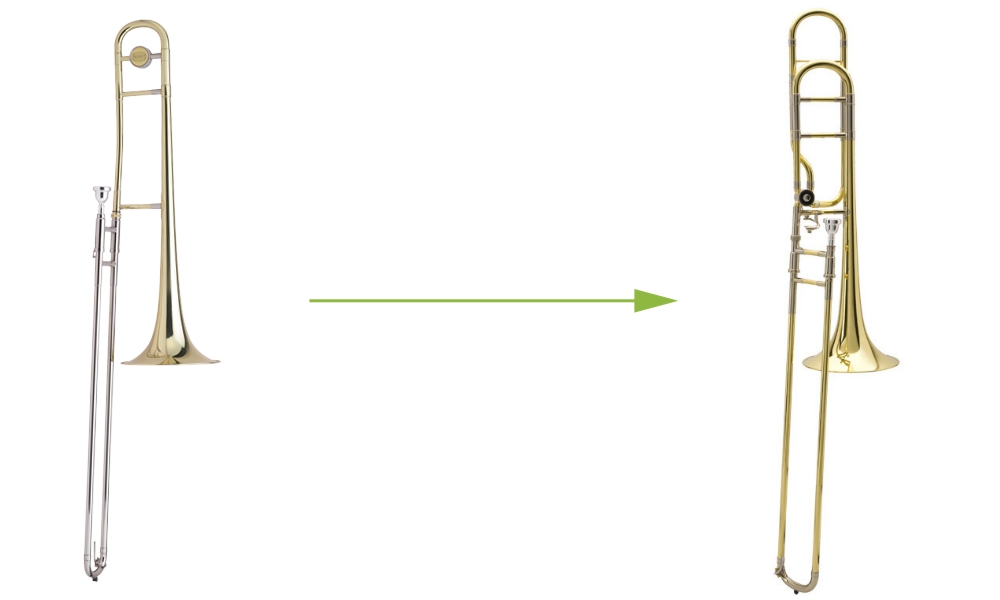
Intermediate instruments will help your child take their musicianship to the next level. Instrument rentals can make this an easy transition in the musical journey for both you and your child. But stepping up in an orchestra is different from stepping up in a band. Here are some things to consider.
- Orchestra (string) students probably shouldn’t upgrade quickly. Wait until they have reached a full-size instrument. You don’t want to end up owning an instrument they’ll outgrow!
If they start on a full-size instrument, however, stepping up is recommended once they decide it’s the instrument for them! - Band students should upgrade as soon as they know they are playing the instrument they want to play throughout their school years (or beyond). This can often be determined within six months to one year of beginning to play their instrument.
- For most students, once they make that upgrade, it will be the last instrument they need. There is not a continual amount of upgrades needed. I’ll explain the only exception to this later. 😉
MOVEMENT 4: Expand Performance Opportunities
Timeframe: Throughout their middle school and high school experiences.
Has your child determined what instrument they’ll stick with for the long haul? Have they moved to an intermediate instrument? If so, it’s time to start expanding their performance opportunities.
Having performance opportunities provides the necessary incentive to continue to improve. If they’re going to play for others, they’re going to want to practice!
They’ll learn that performing in front of others doesn’t end in disaster. Even better, it can be exhilarating (the applause — who doesn’t like that?!). Hopefully, they’ll want to do it more often.
They will naturally have performances as a part of playing in the band or orchestra at school. But there are many other opportunities to perform, both through the school and outside of that setting.
1. Additional School Performances
In addition to the typical band or orchestra concerts throughout the school year, there are other optional opportunities they could take advantage of if encouraged to do so. These are opportunities their band or orchestra director will let them know about, but won’t necessarily require.
Communicating with the director will help you know when these opportunities arise and how best to encourage your child.
- Solo & Ensemble Festival: an opportunity to play alone or in a small group for a rating and feedback
- Honors Bands/Orchestras: an opportunity to perform with other players around the same great skill level
- Pit Orchestra for the school’s musical: this would be for students playing any instrument (woodwind, brass, percussion or strings)
2. Private Lesson Performances
One of the best reasons to take private lessons is the wealth of performance opportunities it provides. Private instructors present students with chances to perform for a crowd and help to ease their nerves.
These events include recitals, competitions, and festivals. Performing with fellow soloists also provides a sense of camaraderie in their musical journey.
3. Local Performances
Retirement homes, churches, sporting events, and community events are just a few places music students can perform. Older kids can also try open mic nights and joining the city’s youth orchestra or a local band. Here are a few avenues to pursue.
- Salvation Army Kettle Drives
- National Anthem for local sporting events (ie. high school basketball, minor league baseball, etc.)
- Local Youth Symphony
- Church Orchestra
- Performing for the family at family gatherings.
MOVEMENT 5: Choose Your Musical Future
Timeframe: Towards the end of high school, especially during college application season!
Once a student is getting into their high school years, they’ll begin thinking about what they want the rest of their life to look like. They’ll need to think about how music will factor into the proverbial equation.
What do they want to do for their career? What role will their musical journey play in their life as an adult?
There are really two paths for their musical life after they graduate: hobbyist or professional.
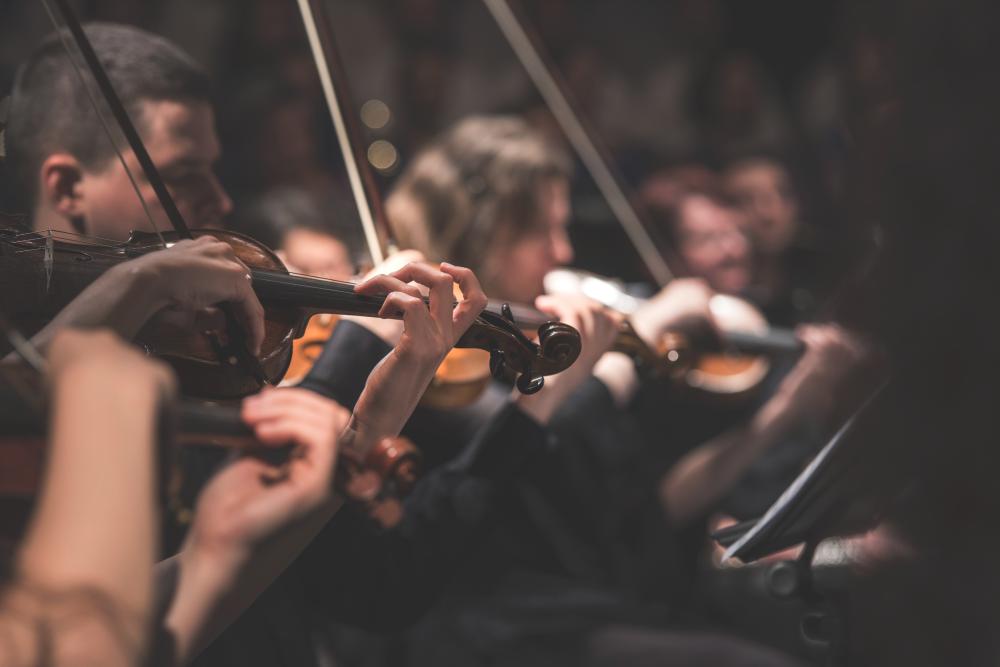
1. Hobbyist
For many of us, music is a hobby that adds color to the daily grind of however we make our living. Hobbyists enjoy playing music in their community for the sheer pleasure it brings them, and some even get paid for their time.
(Wait…wouldn’t that make them a professional? 🤔) 🤷🏼♂️
Opportunities abound for students to pursue music into adulthood, including these examples:
- Community theater
- Church band or orchestra
- Community bands and orchestras
- Sporting events
- Forming a band
- Restaurants and bars
- Open mic nights and coffee shops
2. Professional
At its core, music is more of a passion than a profession.
Some are lucky enough to turn it into both.
Many think of a professional musician as someone who sells out arenas and tours the world. But there are many paths for professional musicians to take.
Your child’s level of interest and commitment, as well as their personality, will determine which musical profession is right for them. Talk to your kids about these future careers in music to help inspire them to practice.
- Symphony orchestra member
- Band member
- Music Educator (band or orchestra director)
- College music professor
- Orchestra conductor
- Sound Designer (gaming or film soundtrack creation)
- Sound Technician
- Recording studio owner
- Church music director
- Instrument Repair Technician
- Private studio teacher
- Composer
- Songwriter
- Music producer
- Music therapist
- Musical Instrument Sales (we’re a little biased toward this one 😉)
- And MANY more…
MOVEMENT 6: Prepare for the Future That’s Chosen
Timeframe: College and beyond.
Once your child has completed their high school music education and determined a path, it’s time to prepare for their future musical journey.
Now might be the time to upgrade to a professional instrument! This is important if they are pursuing a music degree in college or otherwise looking to become a professional.
(It’s also the exception to the “last instrument they’ll need” caveat from earlier!) 😁
Students should also consider location. It’s important to launch a musical career in the right place. Depending on the path they want to pursue, a city alive with musical opportunities might be their best bet.
But every community also needs music teachers, private instructors, and music directors, as well as music hobbyists.
Conclusion
Regardless of what you decide, the beauty of learning an instrument is that it can be enjoyed for a lifetime. (Unfortunately, the same can’t be said about many activities, especially others that pull at the attention of our kids.)
Following these steps … er, movements! … will prepare your child for that lifelong enjoyment!
So, where are you (and your child) on this musical journey? If you’re already a few stages in, have you gleaned any valuable insight? Are there any changes you would make if you could go back to the start of your journey?
We’d love to hear your comments and any helpful tips you can share with those who are just getting started.
Also, do you know someone who could use some guidance? Share this post, so they know where to begin!
Your child’s musical journey is one of the most memorable paths you will travel together. With the right steps, you can sit back and enjoy the sounds, no matter how squeaky the first notes might be.

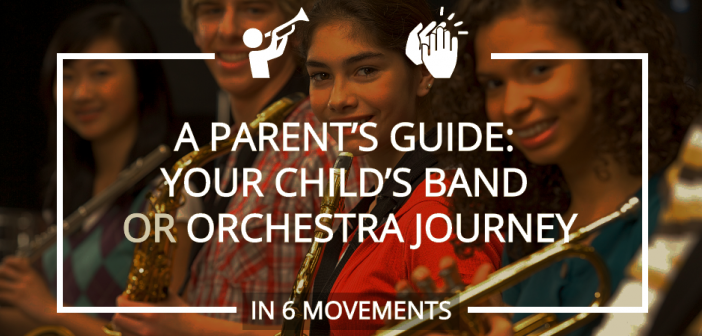

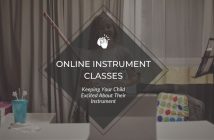

8 Comments
That’s really an informative post. I appreciate your skills. Thanks for Sharing.
Thanks for the kind words – I’m glad it was helpful!
Thank you so much for the detailed explanations! I have one question. Is the path for piano learning different than other band instruments? Do middle schools and high schools usually teach piano as one of the band instruments? My kids have been learning piano for a few years so I would like for them to keep advancing in piano. But if the school doesn’t provide piano instruction and my son ends up choosing a different instrument, I don’t know if we will have time to practice both.
What a great question, Jeanette! Unfortunately, piano is not a regular part of most school band or orchestra instruction. To be clear, there are exceptions to that, but those typically come at the high school level.
The piano is regularly included in the jazz band, if your school has one. In rare instances a school district may even have a middle school jazz band where playing piano would be possible. If your school has a string program, the orchestra may play pieces that include a part for piano, on occasion, as well.
Frequently, students with a piano background are the leaders in their school’s music program, as they have a head start on reading music, understanding rhythm, performing, and so much more. This allows them to not have to learn those things along with the nuts and bolts of playing a new instrument, meaning they tend to progress rapidly.
They also learn incredible skills that they don’t get as readily from playing piano, like making music as a team, learning to lead others etc. if you can find the time, I think it would be well worth it for your children.
Regardless, we’re just happy your kids are involved in music! Talk with your school’s band or orchestra director and see what happens. You never know what will come of it!
If we can ever be of help as you walk this journey with them, please don’t hesitate to reach out!
“My kids have been learning piano for a few years so I Would Like…”
I was an oboist. I studied at Tanglewood, and never imagined for a minute that my daughter would be a singer. However, she has finished her high school career as an Alto, and sang in many All-State ensembles as well as the ACDA Children’s National Honor Choir and also the National Children’s Chorus. It needs to be what your child wants, not what you want…first lesson I learned.
That is such an important lesson for parents to learn. I can’t tell you how often we talk to parents about getting their child started on the instrument they like the sound of best (because they’re going to have to make it make sounds in order to get better!), not the one they already have in their closet (because that would be cheaper than renting one), or the one they played when they were younger. It will be a total waste of the child’s time and the parents’ money for them to be forced to play an instrument they don’t really want to play.
Although I knew quite early that I wanted to play an instrument, I was “talked into” taking clarinet because, as my father claimed, one gets a sore lip from playing brass (at least that was his experience). I did well enough with it, but took up bass clarinet in jr hi school, and then eventually double bass (where I won the school’s orchestra award). My father accused me of wanting to be a “jack of all trades”. I was very involved with music in high school–taking both band and orchestra as classes (at the expense of science classes during two years), participated in the stage band, became a member of the city’s symphony orchestra, and made some money playing “gigs”. However, I did essentially nothing with music during college and grad school and many years afterward (except for leading singing in a church congregation). However, at the age of 68, I decided to get back into music…and decided to try brass, so I bought a Conn 14H trombone from eBay…and took to it like the proverbial fish to water. From there it “snowballed” to trumpet, baritone, alto horn, tuba French horn, valve trombone and mellophonium (most of them Conn instruments) after discovering I liked valves more than slides, and I’m having a lot of fun playing them every day (especially as most of these have transferable fingerings). I also obtained a “contra-alto” clarinet and a few other woodwinds, inclusing a couple Chinese types. I especially like playing various old hymns along with various Chinese marches. My “path” in music is probably quite different from that of most other people, but I’m fascinated with the instruments themselves (including learning how to repair them) as well as the music they create. My father has been gone for a decade now, but today (on my 72nd birthday) I wish he were still alive to see and hear what I’m achieving on these instruments, especially the brass ones (and haven’t experienced any “sore lips”!). BTW, at one point in high school, I was considering going into music as an educator, but my mother convinced me I could go into science (in which I had considerable interest, and followed that path) and still enjoy music on the side. Although I play instruments of various ranges (partly to “round out” my experience), I tend to prefer those in the bass/contrabass range.
You are absolutely right – not everyone’s journey looks exactly like what I’ve described here. I’m glad you’ve found your way in music and are still enjoying it all these years later! You’re why we do what we do – thanks for sharing!